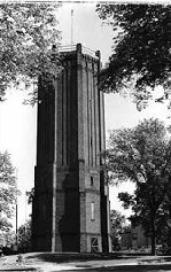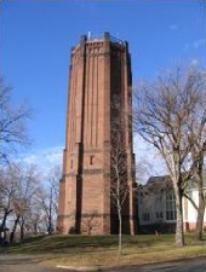Overview
The Kenwood Water Tower draws from various historic architecture styles. This was a common trend in the late 1800s and early 1900s.
- Location: 1724 Kenwood Parkway
- Neighborhood: Kenwood
| 1974 | 2006 |
|---|---|

|

|
The Kenwood Water Tower draws from various historic architecture styles. This was a common trend in the late 1800s and early 1900s.
| 1974 | 2006 |
|---|---|

|

|
The Kenwood Water Tower draws from various historic architecture styles. This was a common trend in the late 1800s and early 1900s.
The tower was built in 1910 to provide water pressure and storage for the hilly Lowry Hill neighborhood. It is a unique visual landmark at the top of the hill overlooking Kenwood Park.
The water tank is made of steel and it is surrounded by an octagonal brick and stone tower. The tower has elements of defensive architecture and resembles a fortress. It has projecting brick ribs at each point of the octagon, narrow rectangular windows, and a Romanesque-arched battlement. This medieval image was fashionable for utilitarian structures from 1890-1910.
Andrew Rinker was the City Engineer when the water tower was built. He may have overseen the design. Rinker served in this role from 1877 to 1893 and again from 1903 to 1913.
The city stopped storing water in the Kenwood Water Tower in 1954. Since then, it has stored radio equipment and a civil defense siren. In 1979, there was momentum to turn the tower into condominiums. The effort was unsuccessful. In the 1990s, the city considered proposals for personal communication services (PCS) antennas on the tower's roof. PCS was an early generation of cell phone technology. This failed due to neighborhood resistance.
Community Planning & Economic Development (CPED)
Phone
Address
Public Service Building
505 Fourth Ave. S., Room 320
Minneapolis, MN 55415